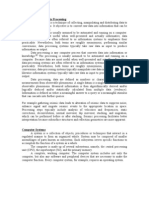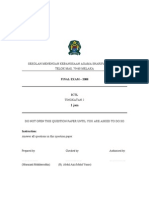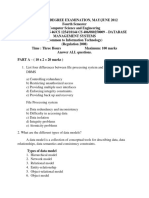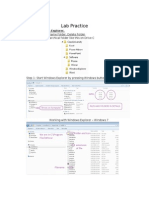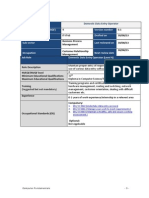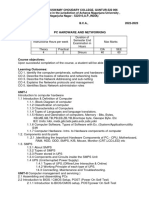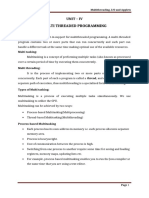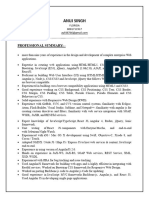Unit 1 Fundamentals of Computer
Uploaded by
pruthvimgowda1997Unit 1 Fundamentals of Computer
Uploaded by
pruthvimgowda1997Fundamentals of computer SRI GOKULA COLLEGE OF ARTS SCIENCE AND MANAGEMENT STUDIES KOLAR
FUNDAMENTALS OF COMPUTER
UNIT 1-FUNDAMENTALS OF COMPUTER\
CHAPTER 1: Introduction to Computer
COMPUTER DEFINITION: It is electronic device, which accepts data, store data, retrieve
data, process data and it will give you the useful result or information.
Data: Raw facts or unprocessed items such as text, audio, video and image etc.
Information/result: Processed data
COMPUTER SYSTEM=HARDWARE+SOFTWARE+USER
Hardware: physical device such as mouse, keyboard, monitor, speaker, printer etc
Software: consists of set of instructions called programs that instructs the computer the tasks to
be performed and how it should be performed.
User: Someone who uses the computer.
Characteristics of Computers
i. Speed : The ability to get answers fast enough so that one has time to take action.
Electrical pulses travel at incredible speeds, because the computer is an electronic
machine, its internal speed is virtually instantaneous. We do not talk in terms of seconds
or even milliseconds. Our units of speed are the microsecond (millionths), the
nanosecond (thousand- millionths) and latterly even the Picoseconds (million-
millionths). A powerful computer is capable of adding together two 18-digit number in
300 to 400 nanoseconds, even the non-numerical environments. The indexing of the
complete students name in the college will consume less time with the help of computer.
ii. Memory: As a human acquires new knowledge, the brain subconsciously selects what it
feels to be important and worth retaining in its memory, and relegates unimportant
details to the back of the mind or just forgets them. Similarly in computers, the primary
memory RAM is used to store the data temporarily.
iii. Storage: After processing, the data and information must be stored in the secondary
storage device, so that the data or information can be used later. The data and
information can be stored permanently in secondary storage devices (or auxiliary
storage). The computer memory is measured using BITS and Bytes.
iv. Accuracy: The computer generated results are exact and without any mistakes with high
rate of consistency.
v. Versatility: Computers seem capable of performing almost any task, provided that the
task can be reduced to series of logical steps.
Pruthvi vm (LECTURE IN BCA dept) BCA
Fundamentals of computer SRI GOKULA COLLEGE OF ARTS SCIENCE AND MANAGEMENT STUDIES KOLAR
vi. Automation: A computer is much more than an adding machine, calculator or check-
in/out system, all of which require human operators to press the necessary keys for the
operations to be performed. Once a program is in the computer’s memory, the individual
instructions are then transferred, one after the other, to the control unit for execution. The
processor/CPU follows these instructions until it meets a last instruction which says stop
program execution.
vii. Diligence: Being a machine, a computer does not suffer from the human traits of
tiredness and lack of concentration. For example, if 3 million calculations have to be
performed, it will perform the 3 millionth with exactly the same accuracy and speed as
the first.
viii. Cost effectiveness: Computers reduce the amount of paper work and human effort,
thereby reducing costs.
History or evolution of computer
Evolution of man and mankind has helped to invent a calculating tool. Early man used stones,
sticks, fingers, pebbles and cowries to count. Even today we calculate using our fingers. The
limitations of the ten fingers and ten toes apparently caused early man to construct a tool for
calculations .Every civilization have contributed calculating tool in their own methods/design.
Mechanical counting devices were made
1. Abacus(2500BC)
Abacus is the first known calculating machine used for counting.
It is made of beads strung on cords and is used for simple arithmetic calculations.
The beads represent digits. Numbers are represented by beads close to the crossbar
Abacus was mainly used for addition, subtraction and later for division and
multiplication.
2. Napier’s bone(1614 AD)
The Napier’s bones was invented by John Napier, a Scottish mathematician
as an aid to multiplication.
A set of bones consisted of nine rods, one for each digit 1 through 9 and a constant rod
for the digit ‘0’.
A rod is similar to one column of a multiplication table.
3. Slide rule(1633 AD)
The Slide Rule was invented by William Oughtred.
It is based on the principle that actual distance from the starting point of the rule is
directly proportional to the logarithm of the numbers printed on the rule.
The slide rule is embodied by the two sets of scales that are joined together, with a
marginal space between them.
IT performs multiplication and division by a method of addition and subtraction.
4. Adding Machine Pascaline (1642 AD)
Pruthvi vm (LECTURE IN BCA dept) BCA
Fundamentals of computer SRI GOKULA COLLEGE OF ARTS SCIENCE AND MANAGEMENT STUDIES KOLAR
The Rotating Wheel Calculator was developed by a French philosopher, Blaise
Pascal invented the first mechanical calculator in 1641. It was named Pascaline.
It had a box with eight movable wheels called dials. The numbers for calculations
were entered with dials. It could add, subtract, divide and multiply the numbers as
big as thousands.
It was using simple components such as gears and levers.
5. Leibniz Calculator
Mathematician Gottfried Leibniz built a calculator in 1650 that could add, subtract,
multiply and divide the numbers.
6. Jacquard loom(1801)
Joseph Mary Jacquard invented a powered loom that used punched wooden cards to
automatically weave incredibly detailed patterns including pictures and text.
This can be taken as the first “read only memory” device.
7. Charles Babbage-Difference Engine-1822
Charles Babbage, British mathematician and engineer, designed an automatic
calculating machine in 1822. He called it a Difference Engine. Later he thought of a
mechanical construction which was known as a mechanical-digital computer.
Babbage called this Analytical engine.
This analytical engine consisted five units, which became the basic principles for the
development of modern computer. Hence Charles Babbage is rightly called the
“Father of Computers”.
8. First Programmer-Lady Ada Lovelace-1833
9.1890 AD-Hollerith tabulating machine
In 1889, an American named Herman Hollerith invented a counting machine to count the
population of USA.
This electronic machine is able to read the information on the punched cards and process
it electronically.
It was one of the main electronic counting devices.
It was based on punch cards.
Herman Hollerith was the founder of the company that became famous as IBM.
BASIC ORGANIZATION OF COMPUTER
There are 4 functional units of computer will be there
1. Input unit
2. Storage unit
3. Central processing unit(cpu)
Pruthvi vm (LECTURE IN BCA dept) BCA
Fundamentals of computer SRI GOKULA COLLEGE OF ARTS SCIENCE AND MANAGEMENT STUDIES KOLAR
4. Output unit
CPU
ALU
Data OUTPUT information
INPUT
DEVICE CU DEVICE
PRIMARY
MEMORY
SECONDARY
MEMORY
STORAGE UNIT
Input unit: It will help to enter data into the system and it will convert high level
language (human understandable language)to machine level language(0’s and 1’s).
Example: Mouse, Keyboard, Joystick, Scanner etc
Storage Unit: It will stores Data, There are two types of memory will be there Primary
memory and Secondary memory.
i. Primary memory: It will stores data temporarily ,it work fastly, Storage capacity
is less compare to secondary memory and it is volatile memory. Example:
RAM(random access memory) &ROM(read only memory)
ii. Secondary memory: It will stores data permanently, it work slow compare to
primary memory, Storage capacity is More compare to secondary memory and it
is non volatile memory. Example: Hard disk, CD, Floppy disk etc
CPU (central processing unit )
Pruthvi vm (LECTURE IN BCA dept) BCA
Fundamentals of computer SRI GOKULA COLLEGE OF ARTS SCIENCE AND MANAGEMENT STUDIES KOLAR
CPU controls, coordinates and supervises the operations of the computer. It is also
responsible for processing of the input data. CPU consists of Arithmetic Logic Unit
(ALU) and Control Unit (CU).CPU also has a set of registers for temporary storage of
data, instructions addresses and intermediate results of calculation.
a. ALU performs all the arithmetic and logic operations on the input data.
b. CU controls the overall operations of the computer i.e. it checks the sequence of
execution of instructions, controls and co-ordinates the overall functioning of the units of
computer.
Output unit: It will display the result and it will convert machine language to high level
language. Example: Monitor, speaker and printer.
Types of Computer
1. Micro computer
2. Mini computer
3. Mainframe computer
4. Super Computer
Micro Computer
Micro computer is also called personal computer.
It was introduced in 1970.
The number of processors in microcomputers will be one or two processors.
It contains input devices, output device, storage device, memory and processor.
It is used by one person at a time.
Examples of personal computers are PC and Apple Macintosh. The major types of
personal computers are desktop computer and portable computer.
Desktop computer: These computers can easily fit on a table or desktop, hence the
name.
Portable Computers Portable is a personal computer that can be carried from one
place to other easily(laptop, notebook)
Mini computer
Mini computers were introduced in the 1960s.
Minicomputer is larger and more powerful computer than personal computer.
It can execute five million instructions per second.
It generally consists of two or more processors.
Mini computer can serve up to 4000 connected users simultaneously.
It is normally accessed by users via personal computer or terminal. A device with
a monitor and keyboard is called terminal. It is also known as dumb terminal.
It has no processing power and cannot work as stand-alone computer.
Examples of mini computers are: VAX-8800, AS 400.
Pruthvi vm (LECTURE IN BCA dept) BCA
Fundamentals of computer SRI GOKULA COLLEGE OF ARTS SCIENCE AND MANAGEMENT STUDIES KOLAR
IT will be used in small scale industries
Mainframe computer
Mainframe computers were introduced in 1975.
A mainframe computer is a very large computer in size.
It is more powerful than minicomputer.
It consists of multiple processors.
It is designed to perform multiple tasks for multiple users at the same time.
Mainframe computers can serve up to 50,000 users at the same time.
The users access a mainframe computer through terminal or personal computer.
A typical main frame computer can execute 16 million instructions per second.
Examples of mainframe computers are NEC610, DEC 10.
It will be used in Large scale industries like
IBM,MUNDTREE,WIPRO,INFOSYS,HP,MICROSOFT ETC
Super Computer
Super computers were introduced in 1980s.
Super computer is the fastest computer.
Super computer is the biggest in size and the most expensive in price than any
other computers.
Tata’s Eka supercomputer in Pune’s Computational Research Laboratories (CRL)
remains the fastest Indian supercomputer.
The government-run Centre For Development of Advanced Computing (C-DAC)
also headquartered in Pune.
Super computer is the most sophisticated, complex and advanced computer. It has
a very large storage capacity.
It can process trillions of instructions in one second
Uses of Super Computers include:
1. Weather forecasting
2. Animated graphics like in Hollywood movies
3. Fluid dynamic calculations
4. Nuclear energy research
5. Space science
6. Weapon and missile design
7. Petroleum exploration etc.
Chapter 2:NUMBER SYSTEM
In digital computers, data and instructions are stored in the computer’s memory using binary
code (or machine code) represented by Binary digIT 's 1 and 0 called BITs.
Pruthvi vm (LECTURE IN BCA dept) BCA
Fundamentals of computer SRI GOKULA COLLEGE OF ARTS SCIENCE AND MANAGEMENT STUDIES KOLAR
The number system uses well defined symbols called digits. The values of digits depend on the
position in which they appear in the number.
Number systems are basically classified into two types. They are,
1. Non-positional number system.
2. Positional number system.
Non-positional number system: Roman number system is an example of the non-
positional number system i.e. I=1, V=5, X=10,
Each of these symbols represents a value, irrespective of the positions. This number
system cannot be used effectively to perform arithmetic operations.
positional number system: Decimal, Binary, Octal and Hexadecimal number systems
are some of the examples of this type of number systems.
It will have positional weight each symbol
The base or radix of a number system is the total number of digits present in any number
system.
1. Decimal number system
This is the most commonly used number system in our daily life. It has 10 numbers from
0 to 9; hence its radix is 10. The positional values are expressed in powers of 10.
Example 3.1 Consider a decimal number 542.76(10) which can be represented in
equivalent value as:
5x102 + 4x101+ 2x100+ 7x10-1 + 6x10-2
2. Binary number system
The representation of data in a computer is usually in binary digits 0 and 1. Hence the
base is 2. The positional values are expressed in powers of 2.
Example : 11011.101(2)
1x24+ 1x23+ 0x22 + 1x21 + 1x20+1x2-1 + 0x2-2 + 1x2-3
3. octal number system
It has 8 digits 0, 1, 2, 3, 4, 5, 6 and 7. Its radix is 8. The positional values are expressed in
powers of 8.
Example: Consider an octal number 234.56(8) which can be represented in equivalent
value as:
2x82+ 3x81 + 4x80 + 5x8-1 + 6x8-2
4. Hexadecimal number system
This number system has 16 digits 0, 1, 2, 3, 4, 5, 6, 7, 8, 9, A, B, C, D, E and F. The radix
is 16. The positional values are expressed in powers of 16. The digits A, B, C, D, E and F
have the decimal equivalents 10, 11, 12, 13, 14 and 15 respectively.
Pruthvi vm (LECTURE IN BCA dept) BCA
Fundamentals of computer SRI GOKULA COLLEGE OF ARTS SCIENCE AND MANAGEMENT STUDIES KOLAR
Example 3.4 Consider a hexadecimal number 5AF.D(16) which can be represented in
equivalent value as:
5x162 + Ax161 + Fx160 + Dx16-1
NOTE: PRACTICE THE PROBLEMS DONE IN CLASS
CONVERSION FROM ONE NUMBER SYSTEM TO ANOTHER
Pruthvi vm (LECTURE IN BCA dept) BCA
You might also like
- Digital Planet: Tomorrow's Technology and You: Hardware BasicsNo ratings yetDigital Planet: Tomorrow's Technology and You: Hardware Basics20 pages
- Name: - Russell D'souza F.Y.BMS Roll No.: - 17 Introduction To Computers Submitted To: - Miss Vileena 2013-2014 Sign100% (1)Name: - Russell D'souza F.Y.BMS Roll No.: - 17 Introduction To Computers Submitted To: - Miss Vileena 2013-2014 Sign17 pages
- Computer Science Notes OBJECTIVE Chapter 1 Class XINo ratings yetComputer Science Notes OBJECTIVE Chapter 1 Class XI22 pages
- Computer Concepts For Commerce: WWW - Isat.guru WWW - Raghug.inNo ratings yetComputer Concepts For Commerce: WWW - Isat.guru WWW - Raghug.in112 pages
- Module 001 Introduction To Computers: Lesson 1: Computer Basics100% (1)Module 001 Introduction To Computers: Lesson 1: Computer Basics11 pages
- Computer Terminology ICET Exam Updated 8th July 2022No ratings yetComputer Terminology ICET Exam Updated 8th July 202260 pages
- Computer First Term Q1 Fill in The Blanks by Choosing The Correct Options (10x1 10)No ratings yetComputer First Term Q1 Fill in The Blanks by Choosing The Correct Options (10x1 10)5 pages
- Fundamental of Computer & Informations Technology BY AMANNo ratings yetFundamental of Computer & Informations Technology BY AMAN24 pages
- Lab Practice: 1. Create Folder, Rename Folder, Delete Folder - 1.1. Create Hierarchical Folder Like This On Drive CNo ratings yetLab Practice: 1. Create Folder, Rename Folder, Delete Folder - 1.1. Create Hierarchical Folder Like This On Drive C16 pages
- Ms-Excel Lecture Notes For Owerri CBT Hi-Tech, Owerri Nigeria100% (2)Ms-Excel Lecture Notes For Owerri CBT Hi-Tech, Owerri Nigeria3 pages
- End Term Examination: Paper Code: BBA - 107 Subject: Computer Fundamentals Paper IDNo ratings yetEnd Term Examination: Paper Code: BBA - 107 Subject: Computer Fundamentals Paper ID5 pages
- 10 Virus and Antivirus Worksheet AnswersNo ratings yet10 Virus and Antivirus Worksheet Answers4 pages
- Psexam Com MCQ Collection For Fundamentals of Comput100% (2)Psexam Com MCQ Collection For Fundamentals of Comput6 pages
- Computing International Roughness Index of Roads From Longitudinal Profile MeasurementsNo ratings yetComputing International Roughness Index of Roads From Longitudinal Profile Measurements16 pages
- Guide To Networking Essentials Fifth Edition: Network Interface CardsNo ratings yetGuide To Networking Essentials Fifth Edition: Network Interface Cards29 pages
- Here Are A Few Tips For Reading Excel Files in A WPF MVVM ApplicationNo ratings yetHere Are A Few Tips For Reading Excel Files in A WPF MVVM Application5 pages
- Electric Machines Laboratory Report-Eee371: To Determine The Turn Ratio of A TransformerNo ratings yetElectric Machines Laboratory Report-Eee371: To Determine The Turn Ratio of A Transformer5 pages
- Assignment 6: (Based On Transportation Problems and Assignment Problems)No ratings yetAssignment 6: (Based On Transportation Problems and Assignment Problems)16 pages
- MICROPROCESSOR Prelim Quiz 1 - Attempt ReviewNo ratings yetMICROPROCESSOR Prelim Quiz 1 - Attempt Review5 pages
- PDF Agile Web Development with Rails Third Edition Sam Ruby downloadNo ratings yetPDF Agile Web Development with Rails Third Edition Sam Ruby download55 pages
- Efficient Online Learning Algorithms Based On LSTM Neural NetworksNo ratings yetEfficient Online Learning Algorithms Based On LSTM Neural Networks12 pages
- Computer - Communication: B.Tech-ECE Pranav Kumar 17BEC0473 Prof. Nandakumar SNo ratings yetComputer - Communication: B.Tech-ECE Pranav Kumar 17BEC0473 Prof. Nandakumar S17 pages
- Digital Planet: Tomorrow's Technology and You: Hardware BasicsDigital Planet: Tomorrow's Technology and You: Hardware Basics
- Name: - Russell D'souza F.Y.BMS Roll No.: - 17 Introduction To Computers Submitted To: - Miss Vileena 2013-2014 SignName: - Russell D'souza F.Y.BMS Roll No.: - 17 Introduction To Computers Submitted To: - Miss Vileena 2013-2014 Sign
- Computer Science Notes OBJECTIVE Chapter 1 Class XIComputer Science Notes OBJECTIVE Chapter 1 Class XI
- Computer Concepts For Commerce: WWW - Isat.guru WWW - Raghug.inComputer Concepts For Commerce: WWW - Isat.guru WWW - Raghug.in
- Module 001 Introduction To Computers: Lesson 1: Computer BasicsModule 001 Introduction To Computers: Lesson 1: Computer Basics
- Computer Terminology ICET Exam Updated 8th July 2022Computer Terminology ICET Exam Updated 8th July 2022
- Computer First Term Q1 Fill in The Blanks by Choosing The Correct Options (10x1 10)Computer First Term Q1 Fill in The Blanks by Choosing The Correct Options (10x1 10)
- Fundamental of Computer & Informations Technology BY AMANFundamental of Computer & Informations Technology BY AMAN
- Lab Practice: 1. Create Folder, Rename Folder, Delete Folder - 1.1. Create Hierarchical Folder Like This On Drive CLab Practice: 1. Create Folder, Rename Folder, Delete Folder - 1.1. Create Hierarchical Folder Like This On Drive C
- Ms-Excel Lecture Notes For Owerri CBT Hi-Tech, Owerri NigeriaMs-Excel Lecture Notes For Owerri CBT Hi-Tech, Owerri Nigeria
- End Term Examination: Paper Code: BBA - 107 Subject: Computer Fundamentals Paper IDEnd Term Examination: Paper Code: BBA - 107 Subject: Computer Fundamentals Paper ID
- Psexam Com MCQ Collection For Fundamentals of ComputPsexam Com MCQ Collection For Fundamentals of Comput
- Computing International Roughness Index of Roads From Longitudinal Profile MeasurementsComputing International Roughness Index of Roads From Longitudinal Profile Measurements
- Guide To Networking Essentials Fifth Edition: Network Interface CardsGuide To Networking Essentials Fifth Edition: Network Interface Cards
- Here Are A Few Tips For Reading Excel Files in A WPF MVVM ApplicationHere Are A Few Tips For Reading Excel Files in A WPF MVVM Application
- Electric Machines Laboratory Report-Eee371: To Determine The Turn Ratio of A TransformerElectric Machines Laboratory Report-Eee371: To Determine The Turn Ratio of A Transformer
- Assignment 6: (Based On Transportation Problems and Assignment Problems)Assignment 6: (Based On Transportation Problems and Assignment Problems)
- PDF Agile Web Development with Rails Third Edition Sam Ruby downloadPDF Agile Web Development with Rails Third Edition Sam Ruby download
- Efficient Online Learning Algorithms Based On LSTM Neural NetworksEfficient Online Learning Algorithms Based On LSTM Neural Networks
- Computer - Communication: B.Tech-ECE Pranav Kumar 17BEC0473 Prof. Nandakumar SComputer - Communication: B.Tech-ECE Pranav Kumar 17BEC0473 Prof. Nandakumar S


